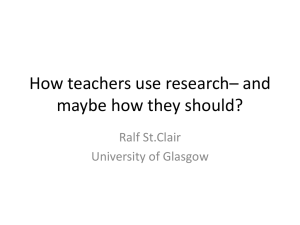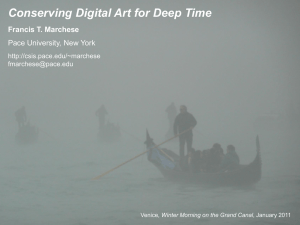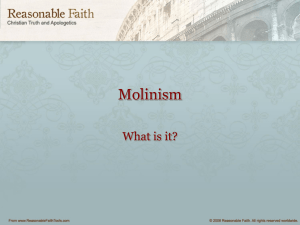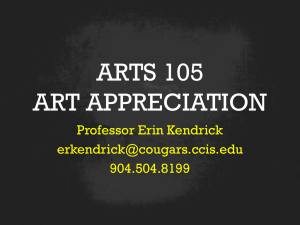Unit: Humans in Nature Lesson 2 Name: Elly Golterman Lesson Title
advertisement
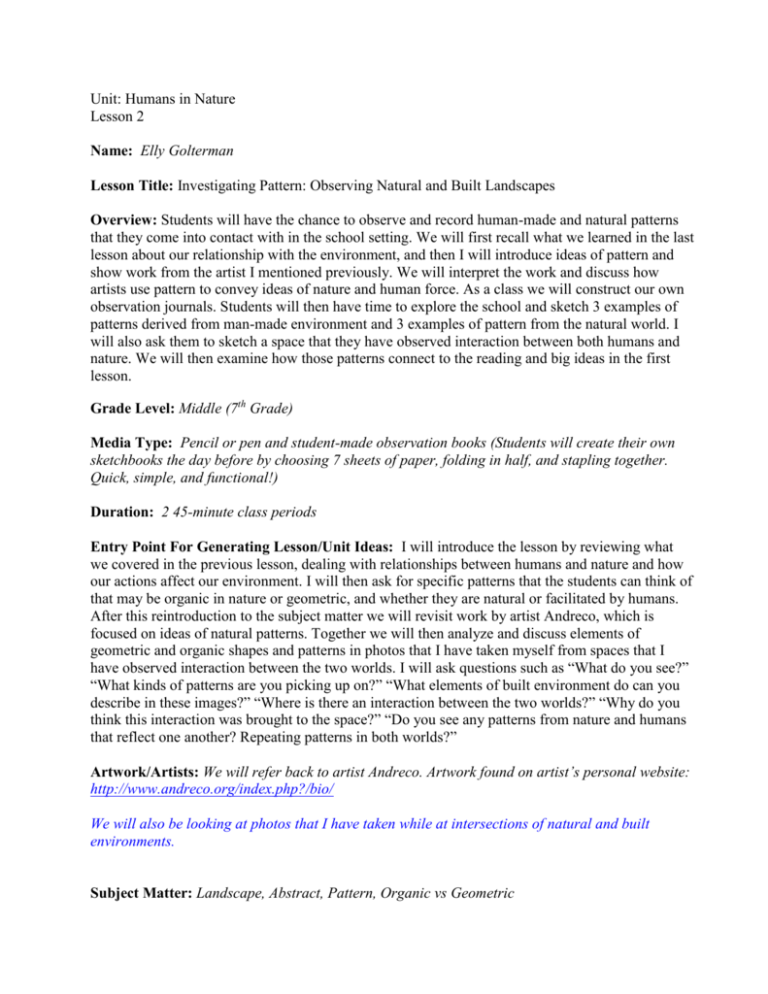
Unit: Humans in Nature Lesson 2 Name: Elly Golterman Lesson Title: Investigating Pattern: Observing Natural and Built Landscapes Overview: Students will have the chance to observe and record human-made and natural patterns that they come into contact with in the school setting. We will first recall what we learned in the last lesson about our relationship with the environment, and then I will introduce ideas of pattern and show work from the artist I mentioned previously. We will interpret the work and discuss how artists use pattern to convey ideas of nature and human force. As a class we will construct our own observation journals. Students will then have time to explore the school and sketch 3 examples of patterns derived from man-made environment and 3 examples of pattern from the natural world. I will also ask them to sketch a space that they have observed interaction between both humans and nature. We will then examine how those patterns connect to the reading and big ideas in the first lesson. Grade Level: Middle (7th Grade) Media Type: Pencil or pen and student-made observation books (Students will create their own sketchbooks the day before by choosing 7 sheets of paper, folding in half, and stapling together. Quick, simple, and functional!) Duration: 2 45-minute class periods Entry Point For Generating Lesson/Unit Ideas: I will introduce the lesson by reviewing what we covered in the previous lesson, dealing with relationships between humans and nature and how our actions affect our environment. I will then ask for specific patterns that the students can think of that may be organic in nature or geometric, and whether they are natural or facilitated by humans. After this reintroduction to the subject matter we will revisit work by artist Andreco, which is focused on ideas of natural patterns. Together we will then analyze and discuss elements of geometric and organic shapes and patterns in photos that I have taken myself from spaces that I have observed interaction between the two worlds. I will ask questions such as “What do you see?” “What kinds of patterns are you picking up on?” “What elements of built environment do can you describe in these images?” “Where is there an interaction between the two worlds?” “Why do you think this interaction was brought to the space?” “Do you see any patterns from nature and humans that reflect one another? Repeating patterns in both worlds?” Artwork/Artists: We will refer back to artist Andreco. Artwork found on artist’s personal website: http://www.andreco.org/index.php?/bio/ We will also be looking at photos that I have taken while at intersections of natural and built environments. Subject Matter: Landscape, Abstract, Pattern, Organic vs Geometric Concepts: Exploring new ways of looking at our environment, specifically through pattern. Considering spaces that hold relationships between nature and humans in our own daily environments. Enduring Ideas: Humans vs. Nature—Students will explore the relationship between the two worlds, how humans have altered and built our environment, and how nature has responded to us. Theme: Art and Discovery Rationale: Students will have the opportunity to investigate their personal surroundings in terms of humans and nature. They will be forced to see their environments (school setting and out of school spaces) in a new light, through a lens of pattern projected onto a landscape or place. The previous lesson was introducing this enduring idea, and students will now be able to put the concept into perspective and make it relevant to them, allowing for personal investment in the project. In order for students to fully understand an idea they must be able to integrate it into their own lives, which is what this lesson is set up to do. Through observation of the school grounds and then of their home setting outside of school (for homework), students will be able to integrate critical thinking of their own role in the environment into their lives. Objective(s) for Planning/Product: Students will participate in discussion of previous lesson, talking about the artist Andreco and how he utilizes pattern to point out issues in our environment. Students will observe and think critically about the intersections of humans and nature, and how our decisions facilitate patterns and interaction with the landscape. Students will incorporate the ideas that they have learned into applicable knowledge through observation of their surroundings. Students will demonstrate knowledge of patterns in nature and built landscape within their community and in history. Objective(s) for Student Reflection: Students will share their thoughts and answers to the questions asked about images and artist. Students will discuss issues related to humans in nature relating to artwork by Andreco. Students will consider the ways that they personally interact with nature, and explore patterns relating to natural and built landscapes and forms. Students will record their observations in a personal journal, presenting their new knowledge of patterns relating to both natural and human worlds. Assessment: Students will be assessed by their participation in discussion of images and artwork at the beginning of class. They will also be accountable for communicating ideas of how they personally interact with nature, and examples that they can think of in terms of those interactions in the real world. They will turn in their journals after they have completed both in-class and out of class assignments, which I will assess in completion and understanding. Content and Achievement Standards: CR.1.7.1 Apply strategies to combat and overcome blocks in the creative process (e.g., sketching, brainstorming, journaling) R.8.7.1 Evaluate art by considering a variety of components subject matter form mood traditional and/or new media relevant context information visual elements structure CN.11.7.1 Analyze the manner in which responses to art reflect changing times, traditions, resources, and cultures Materials: Pencils/pens, construction paper, hole punch, string, photos. Procedure: I will introduce the lesson by reviewing what we covered in the previous lesson, dealing with relationships between humans and nature and how our actions affect our environment. I will then ask for specific patterns that the students can think of that may be organic in nature or geometric, and whether they are natural or facilitated by humans. After this reintroduction to the subject matter we will revisit work by artist Andreco, which is focused on ideas of natural patterns. Together we will then analyze and discuss elements of geometric and organic shapes and patterns in photos that I have taken myself from spaces that I have observed interaction between the two worlds. I will ask questions such as “What do you see?” “What kinds of patterns are you picking up on?” “What elements of built environment do can you describe in these images?” “Where is there an interaction between the two worlds?” “Why do you think this interaction was brought to the space?” “Do you see any patterns from nature and humans that reflect one another? Repeating patterns in both worlds?” After discussion the class will participate in creating our own observation journals. Each student will choose 7 sheets of paper, fold them in half, 3 hole punch them, and tie them together with string. This introduction and journal making will take up the first class period. Students will be assigned a homework assignment of recording 3 instances that they have observed interaction between nature and humans, in terms of pattern. They will use examples given earlier in class for reference if they are stuck. I will give more examples than what was shown, such as fences and grass, tall buildings and potted plants, bricks and ivy, sidewalks and landscaped greenery, etc. Students will bring back journals for the next class period. During the next class, students will begin class by opening their journals to a page of their choice, and we will travel around the room to look at each student’s observations. I will ask questions to facilitate conversation and reminders of what we talked about based on the images that they bring. Students will then be able to take the remainder of the class to observe the school grounds for interactions between nature and humans. They will record 3 human made patterns, 3 organic patterns, and 3 patterns that show interaction and relationships between the worlds. 15 minutes to the end of class they will return to the classroom and we will discuss what they found. I will have 3 students share their observations. Resources: Artist Andreco’s Personal Website http://www.andreco.org/index.php?/otherworks/paints/ Images of real-world relationships between humans and nature, included in beginning of lesson.



